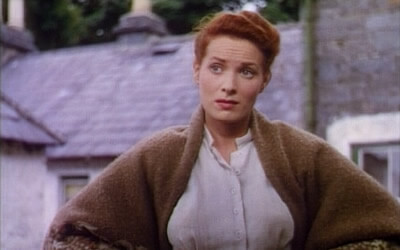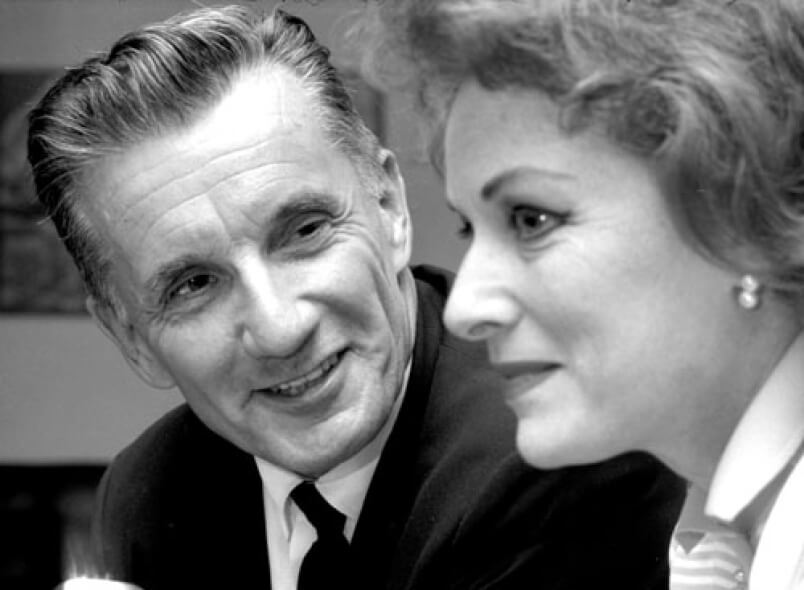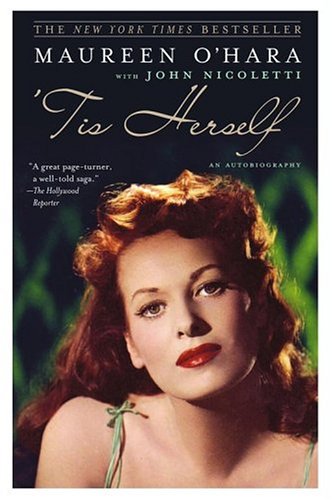Ricochet is the best place on the internet to discuss the issues of the day, either through commenting on posts or writing your own for our active and dynamic community in a fully moderated environment. In addition, the Ricochet Audio Network offers over 50 original podcasts with new episodes released every day.
 A Love Letter to Herself
A Love Letter to Herself
“Well, some things a man doesn’t get over so easy … Like the sight of a girl coming through the fields with the sun on her hair … kneeling in church with a face like a saint…” — John Wayne to Maureen O’Hara in The Quiet Man
I had seen her dozens of times before, but always in black and white. She flickered across my TV screen as the hauntingly beautiful Esmeralda in The Hunchback of Notre Dame and as the exasperated Mrs. Walker in the original Miracle on 34th Street. But at age 12, my folks bought their first color television and I saw Maureen FitzSimons, aka, Maureen O’Hara, in The Quiet Man.
Like John Wayne’s character, Sean Thornton, my first sight of her in glorious Technicolor was as she moved sheep across an Irish meadow with the sunlight shining on that marvelous head of red hair. By the time the movie was over, I was thoroughly convinced that if that is what women were all about, I wanted to be involved.
On the screen she was more radiant than that sunshine. She was everything that the playwright Philip Barry said in describing his character Tracy Lord in The Philadelphia Story: There was a magnificence that came out of her eyes, in her voice, in the way she stood there, in the way she walked. She was lit from within with fires banked down in her, hearth-fires and holocausts.
Now, one should ever confuse the actor and the role, but there was a lot of Mary Kate Danaher in Maureen O’Hara and vice versa. When explaining the chemistry she had with Wayne she simply said, “I was tough. I was tall. I was strong. I didn’t take any nonsense from anybody. He was tough, he was tall, he was strong and he didn’t take any nonsense from anybody. As a man and a human being, I adored him.”
 The US Government got a piece of that no nonsense woman. When applying for U.S. citizenship in 1946, the government clerk had crossed off the word “Irish” and replaced it with the word “English” everywhere it appeared. Up until that moment it was State Department policy to designate Irish citizens as “English.”
The US Government got a piece of that no nonsense woman. When applying for U.S. citizenship in 1946, the government clerk had crossed off the word “Irish” and replaced it with the word “English” everywhere it appeared. Up until that moment it was State Department policy to designate Irish citizens as “English.”
“I’m terribly sorry,” she told the clerk, “but I can’t forswear an allegiance I don’t have. I have no allegiance to England at all – I’m Irish.”
Tell it to the judge, she was told. And she did. Refusing to comply she yelled at the immigration judge on the way out, “Your Honor, do you realize what you are trying to do my children and grandchildren? You’re trying to take away their right to boast about their wonderful Irish mother and grandmother!”
The judge threw up his hands, ordered the clerk to comply with O’Hara’s wishes and then ordered her removed from the court.
She had come to America at age 17, brought here by the great Charles Laughton after her training at Dublin’s famed Abbey Theatre. She was to be the Esmeralda to his Hunchback. He had given her a contract with his production company, Mayflower Pictures, but when the war broke out and he was unable to film in London any longer, Laughton was forced to sell her contract to RKO. She languished there until she met director John Ford, who rescued her by casting her as Angharad in How Green Was My Valley.
It was Ford that paired her with Wayne, for the first of five times, in what would be the last of Ford’s cavalry trilogy, Rio Grande (1950). Executives at Republic Pictures had doubts about The Quiet Man and wanted a western from the trio first. That, the studio reasoned, would help defray the cost of Man‘s location shooting in Ireland. Little did they know that Man would not only be a box office success, it would be the only picture the studio would ever produce to be nominated as Best Picture.
Set in the 1920’s, The Quiet Man is a romance that is defined by the age when women definitely subjected themselves to men, be it their fathers, their older brothers or their husbands. But O’Hara played Mary Kate Danaher with defiance. Yes, she would abide society’s rules, but she would do so only on her own terms.
At one point, Michaeleen Oge Flynn, the matchmaker played by Barry Fitzgerald, turns to Sean (Wayne) and says, “..and her with her freckles and her temper. Oh, that red head of hers is no lie.”
When her older brother, Red Will (Victor McLaglen), refuses to turn over her dowry, she refuses the wedding bed, believing that she’s not really married without it. It results in Mary Kate leaving Sean. Thornton grabs her off the train and literally drags her back to her brother.
Sean: You can take your sister back. It’s your custom, not mine. No fortune, no marriage. We call it quits.
Mary Kate: You’d do this to me, your own wife?
Sean: It’s done.
Red Will: There’s your dirty money. (Throwing it on the ground) Take it. Count it, you spawn, and look. If ever I see that face of yours again, (showing his fist) I’ll push that through it.
Sean picks up the money and Mary Kate opens the door of a boiler so he can throw it into the fire, she then turns from Sean and gives the assembled crowd the most perfect look of satisfaction. “I’ll be goin’ on home now. I’ll have the supper ready for you.”
 She’s won. Her husband and her brother are about to engage in a legendary donnybrook but now she has their respect. All of them. Just like Maureen O’Hara in immigration court, she gets what she wants and she gets it on her own terms.
She’s won. Her husband and her brother are about to engage in a legendary donnybrook but now she has their respect. All of them. Just like Maureen O’Hara in immigration court, she gets what she wants and she gets it on her own terms.
At the end of the picture, Ford wanted a particular look from Wayne before he had the couple retreat back into the cottage. He wanted Maureen to whisper something into Duke’s ear and when told what to say she balked.
“No. I can’t. I can’t say that to Duke.” Ford insisted, “I’m telling you, you are to say it!”
She relented, but again, only on her terms. Whatever it was she said, all three would have to agree to take it to the grave. And so they did, but one of cinema’s perfect moments was born.
She wasn’t always so lucky off-screen. Her first marriage came too soon at age 19 and ended in annulment, the second one was abusive (her second husband, director William Houston Price conspired with a doctor to murder her), and a relationship with Mexican millionaire Enrique Parra was sabotaged by his family. The best years for her was her marriage to aviator Charles F. Blair, Jr. A retired Air Force General and former Chief Pilot for Pan Am, Blair provided for her in real life the kind of partner Duke had given her on the screen.
 Blair founded Antilles Air Boats, an airline that flew routes between New York and the Caribbean. On September 2, 1978 Blair was piloting a Grumman Goose between St. Croix and St. Thomas when the engine exploded, plunging the craft into the sea, killing him and three of his passengers. She fought the NTSB tooth-and-nail when the initial finding came back as “pilot error.”
Blair founded Antilles Air Boats, an airline that flew routes between New York and the Caribbean. On September 2, 1978 Blair was piloting a Grumman Goose between St. Croix and St. Thomas when the engine exploded, plunging the craft into the sea, killing him and three of his passengers. She fought the NTSB tooth-and-nail when the initial finding came back as “pilot error.”
O’Hara assumed control of Air Boats, becoming the first woman in the US to head an airline with regularly scheduled passenger service, and ran it until she could sell it off with the blessings of the shareholders.
Having outlived Ford, the Duke and most of her contemporaries, O’Hara retired from show business. Almost twenty years after she made her last picture with Wayne she would find renewed success with a new screen partner named John — the big, burly comedian, John Candy. In 1990, Chris Columbus sent her the script for Only the Lonely, a part he wrote for her while imagining Mary Kate Danaher as widowed and living with her son in Chicago. It would only take a 10-minute meeting with Candy to get her to say “yes.”
 Like every other man that worked with her, Candy was charmed by the legendary redhead. When he saw the appalling accommodations she was given on the set, Candy went to the producers to demand better. He was told the money was being spent for the movie, not trailers for aging movie stars. So John gave Maureen his trailer and slept on a cot in cramped quarters for three days until she was given the treatment he thought she deserved.
Like every other man that worked with her, Candy was charmed by the legendary redhead. When he saw the appalling accommodations she was given on the set, Candy went to the producers to demand better. He was told the money was being spent for the movie, not trailers for aging movie stars. So John gave Maureen his trailer and slept on a cot in cramped quarters for three days until she was given the treatment he thought she deserved.
In Candy, she saw echoes of her mentor, Charles Laughton. Every morning she greeted him, “Who came to work today, John? John Candy, the funnyman, or John Candy, the actor?” John would look down sheepishly and then raise his head and proudly say, “The actor.”
The experience was so pleasant for both that they decided to make a second picture together, even having found a suitable story about a man who hires a grandmother for his children. But it was not to be.
When he was to leave for Mexico to film Wagons East, he called Maureen and told her that he didn’t want to go. He had a bad feeling about the picture and a bad feeling about the trip. Three weeks later, Candy was dead of a heart attack.
Now, Mary Kate Danaher is gone, too. Surely, an angel will see her and wonder who the new girl is, the one with the ginger hair, the elegant voice and the one that seems lit from within.
Aghast, Saint Peter asks, “Don’t you know?”
‘Tis Herself.
Published in General



The movie was special on many levels, not the least of which is that is was a family affair. Maureen’s brothers Charlie and James both had prominent roles, as did Francis Ford (older brother of John) and Arthur Shields, the man who played the Revered Playfair was the brother of Barry Fitzgerald.
The children surrounding Maureen at the horse race have a pretty good pedigree, too. They belong to Wayne.
Great tribute. I can’t resist the temptation to record one nit pick, however:
The Grumman Goose is a two-engine aircraft.
Thank you! Thank you! Thank you, EJ, for this beautiful tribute to a beautiful woman – and to a beautiful film. Every year around St. Patrick’s Day I pull out my DVD of The Quiet Man and enjoy an evening watching that magnificent movie again. Every actor is ideal for the role he or she portrays, the cinematography is wonderful, the dialogue is perfectly crafted – it shows how Hollywood’s greatest directors could really knock it out of the park using techniques that are, by today’s CGI standards, primitive: just great actors reciting great dialogue with camerawork that unobtrusively enhances the film without overwhelming it.
And, of course, John Wayne and Margaret O’Hara. Michaleen Flynn summed her up best:
…and her with her freckles and her temper. Oh, that red head of hers is no lie.
There are plenty of instances when twin engine aircraft auger in when one of the engines goes. You’re losing 50 percent power suddenly and catastrophically, after all. Seems to happen to the older F-18’s quite a bit (ironic since the Navy specified two engines for the supposed safety benefits).
What a woman. What a life. She was always my ideal of a strong, feminine woman.
Our oldest daughter has Maureen’s red hair, “attractive” in the sense that strangers were drawn to her when she was young. The glories of technicolor make Ms. O’Hara’s hair in Quiet Man equally arresting and attractive, but her eyes and smile make Mr. Thornton’s smitten-ness perfectly reasonable and inevitable.
Thanks, EJ for the lovely tribute.
Thank you, E.J. That was wonderful.
Just a few days ago, we were watching a Doris Day movie and I commented that there’s only a few Golden Age stars left: Day, Olivia de Havilland, Kirk Douglas, and Maureen O’Hara (I’m sure I’m missing someone, too). Well, now there’s one less.
Our loss.
One of my favorite movies and actresses – back when they made so many timeless classics . Turner Movie Classics is our favorite station – she never made a bad movie – she made the movie! The Quiet Man was stunning. What a great life and legacy – thank you for the post – loved the last line about the angel!
Very nice EJ. Very nice.